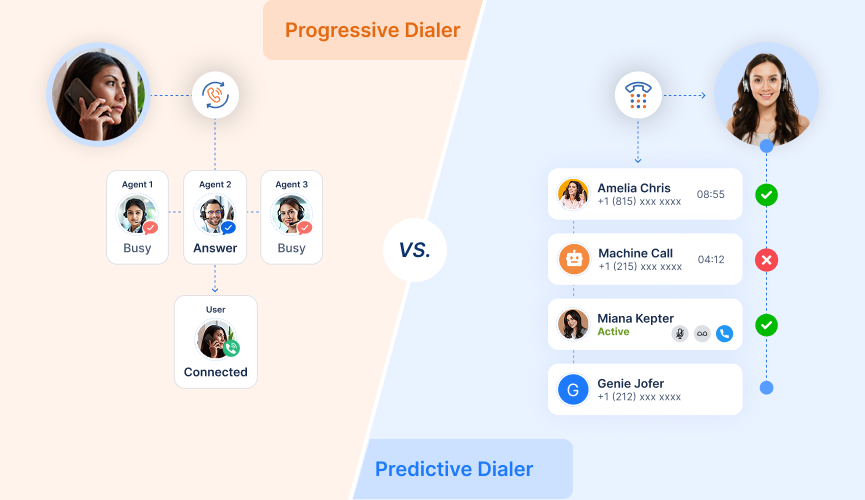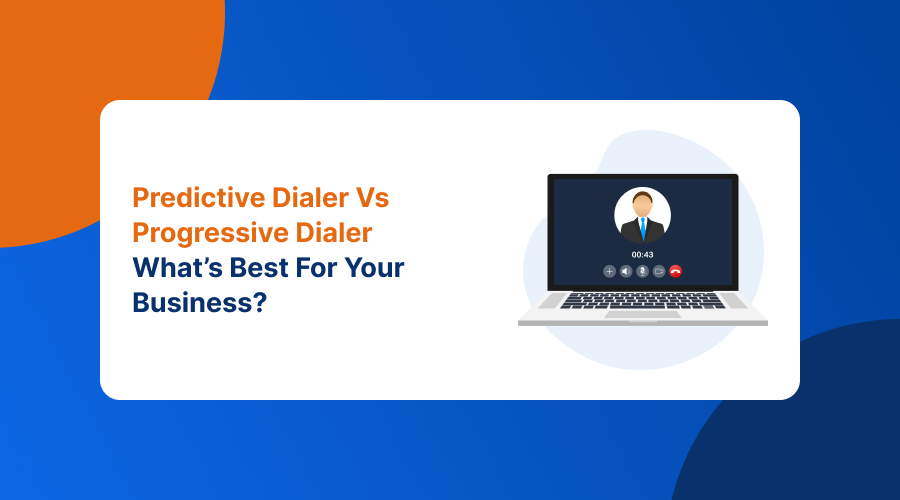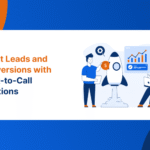Organizations want agents to connect faster; however, customers expect calls to feel authentic and have relevant engagement. That’s where the argument about predictive dialer vs progressive dialer truly starts.
The two types of auto dialing technology can absolutely enhance outbound calling, but in very different ways. Predictive dialers are focused on the rapidity and volume, while progressive dialers keep the focus on the quality and connection.
In this blog, we will inform you on both types, evaluate the advantages and disadvantages of each, provide practical use cases, and subsequently guide you to the best way to meet your goals for your business.
What Is a Predictive Dialer?
Imagine a busy morning in your sales department. Your agents are ready to reach out to leads. However, all of that wasted time between calls can lead to lost opportunities. A predictive dialer can help with this by dialing multiple numbers at the same time, and only connecting answered calls to available agents.
How It Works:
- The system automatically dials several numbers per agent.
- When someone answers, the call is instantly connected to an available agent.
- If no one answers or it hits voicemail, it moves on automatically.
When It Works The Best:
For example:
- Telemarketing campaigns: Reach thousands of leads quickly.
- Debt collection or payment reminders: Maximize contact rate within a limited time.
- Surveys and feedback drives: Collect large-scale responses efficiently.
What Is a Progressive Dialer?
How It Works:
- Once an agent completes a call, they can review the customer’s details before the next dial.
- The system then automatically dials the next number,so no manual dialing, no over-dialing.
- The agent is immediately available to speak when the call connects.
When comparing progressive dialer vs predictive dialing, this slower, customer-centric approach often wins where personalization and compliance are key.
When It Works The Best:
Progressive dialers shine in relationship-driven campaigns where context and personalization matter most:
- Customer renewals or retention calls: Build loyalty through genuine conversations.
- B2B sales or account management: Allow agents to tailor each pitch.
- Follow-ups or post-sales support: Deliver consistent, quality engagement.
Here, the progressive dialer empowers agents to prepare, personalize, and perform every single time.
Predictive vs Progressive Dialer: A Clear Comparison
We have prepared a table to highlight the differences between these two dialing techniques:
| Feature | Predictive Dialer | Progressive Dialer |
|---|---|---|
| Dialing Method | Dials multiple numbers simultaneously using AI prediction | Dials one number only when the agent is ready |
| Agent Control | Low because the system decides when to connect calls | High because the agent reviews and controls the call flow |
| Call Volume | Very high | Moderate |
| Efficiency | Maximizes agent talk time | Maximizes call quality |
| Abandoned Calls | Can occur if over-dialed | None or minimal |
| Customer Experience | Slight delay possible | Immediate and personal |
| Compliance | Needs close monitoring | Easier to stay compliant |
| Best For | High-volume campaigns | Relationship-driven campaigns |
When comparing predictive dialer vs progressive dialer, the real difference comes down to intent. Predictive dialing is about numbers; progressive dialing is about accuracy.
If your priority is speed, predictive is the winner, and if your goal is quality, progressive takes the lead.
Use Cases of Predictive and Progressive Dialing
These real-world predictive dialers vs progressive dialers examples show how both models perform in practice.
Predictive Dialer Example:
Progressive Dialer Example:
A SaaS company focuses on upselling existing clients. With a progressive dialer, agents take a moment to review client histories before calling. The result? More personal conversations and higher upgrade rates because quality drives conversions.
Here, we can clearly observe that both approaches deliver results, but for entirely different reasons.
For Realtime Use Cases Checkout: UP112 Case Study or Pure Ev Case Study
Choosing Between Predictive and Progressive Dialers
Choosing between a predictive dialer vs progressive setup dialer depends on the campaign goals, customer expectations, and team dynamics.

Choose a Predictive Dialer if:
- You want as many contacts as possible.
- You manage large lists or time-sensitive campaigns.
- You want to maximize agent talk time.
Choose a Progressive Dialer if:
- You focus on customer experience and personalization.
- You run high-value, B2B campaigns.
- You want to ensure compliance with few abandoned calls.
Some businesses even blend both using predictSome businesses even blend both, using predictive for bulk outreach and progressive for targeted follow-ups.
Why Using DeepCall is the Ultimate Solution?
At Sarv.com, we believe communication tools should adapt to your goals, but not the other way around. That’s why our DeepCall platform integrates both predictive and progressive dialers in one powerful, easy-to-use system.
With DeepCall, you can:
- Instantly switch between dialing modes depending on campaign type.
- Monitor performance through live analytics and reporting.
- Stay compliant with intelligent call pacing and automation controls.
- Empower agents with CRM data and customer insights on one screen.




